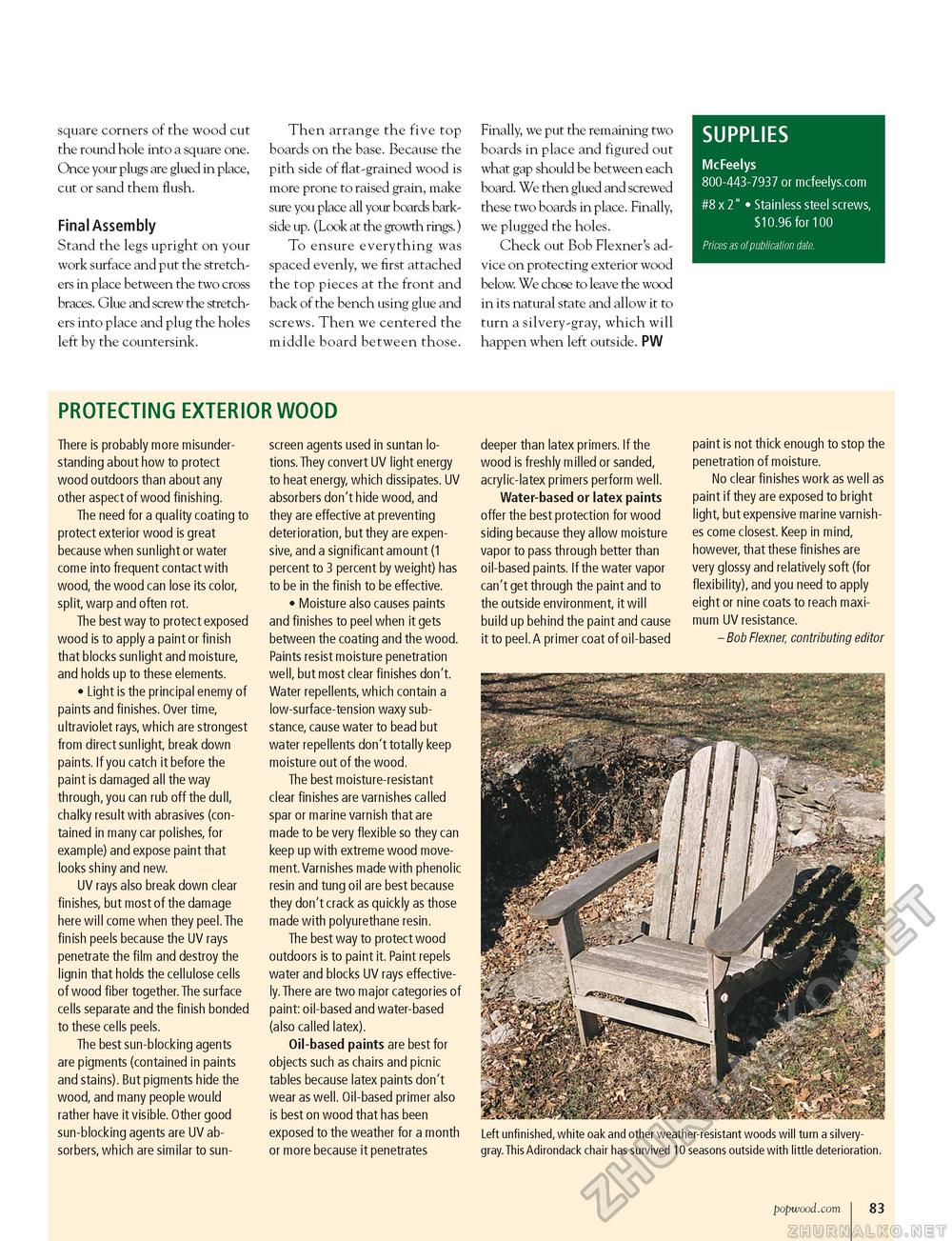Popular Woodworking 2004-04 № 140, страница 85
SUPPLIES McFeelys 800-443-7937 or mcfeelys.com #8 x 2" • Stainless steel screws, $10.96 for 100 Prices as of publication date. square corners of the wood cut the round hole into a square one. Once your plugs are glued in place, cut or sand them flush. Final Assembly Stand the legs upright on your work surface and put the stretchers in place between the two cross braces. Glue and screw the stretchers into place and plug the holes left by the countersink. Then arrange the five top boards on the base. Because the pith side of flat-grained wood is more prone to raised grain, make sure you place all your boards bark-side up. (Look at the growth rings.) To ensure everything was spaced evenly, we first attached the top pieces at the front and back of the bench using glue and screws. Then we centered the middle board between those. Finally, we put the remaining two boards in place and figured out what gap should be between each board. We then glued and screwed these two boards in place. Finally, we plugged the holes. Check out Bob Flexner's advice on protecting exterior wood below. We chose to leave the wood in its natural state and allow it to turn a silvery-gray, which will happen when left outside. PW PROTECTING EXTERIOR WOOD There is probably more misunderstanding about how to protect wood outdoors than about any other aspect of wood finishing. The need for a quality coating to protect exterior wood is great because when sunlight or water come into frequent contact with wood, the wood can lose its color, split, warp and often rot. The best way to protect exposed wood is to apply a paint or finish that blocks sunlight and moisture, and holds up to these elements. • Light is the principal enemy of paints and finishes. Over time, ultraviolet rays, which are strongest from direct sunlight, break down paints. If you catch it before the paint is damaged all the way through, you can rub off the dull, chalky result with abrasives (contained in many car polishes, for example) and expose paint that looks shiny and new. UV rays also break down clear finishes, but most of the damage here will come when they peel.The finish peels because the UV rays penetrate the film and destroy the lignin that holds the cellulose cells of wood fiber together. The surface cells separate and the finish bonded to these cells peels. The best sun-blocking agents are pigments (contained in paints and stains). But pigments hide the wood, and many people would rather have it visible. Other good sun-blocking agents are UV absorbers, which are similar to sun screen agents used in suntan lotions. They convert UV light energy to heat energy, which dissipates. UV absorbers don't hide wood, and they are effective at preventing deterioration, but they are expensive, and a significant amount (1 percent to 3 percent by weight) has to be in the finish to be effective. • Moisture also causes paints and finishes to peel when it gets between the coating and the wood. Paints resist moisture penetration well, but most clear finishes don't. Water repellents, which contain a low-surface-tension waxy substance, cause water to bead but water repellents don't totally keep moisture out of the wood. The best moisture-resistant clear finishes are varnishes called spar or marine varnish that are made to be very flexible so they can keep up with extreme wood movement. Varnishes made with phenolic resin and tung oil are best because they don't crack as quickly as those made with polyurethane resin. The best way to protect wood outdoors is to paint it. Paint repels water and blocks UV rays effectively. There are two major categories of paint: oil-based and water-based (also called latex). Oil-based paints are best for objects such as chairs and picnic tables because latex paints don't wear as well. Oil-based primer also is best on wood that has been exposed to the weather for a month or more because it penetrates deeper than latex primers. If the wood is freshly milled or sanded, acrylic-latex primers perform well. Water-based or latex paints offer the best protection for wood siding because they allow moisture vapor to pass through better than oil-based paints. If the water vapor can't get through the paint and to the outside environment, it will build up behind the paint and cause it to peel.A primer coat of oil-based paint is not thick enough to stop the penetration of moisture. No clear finishes work as well as paint if they are exposed to bright light, but expensive marine varnishes come closest. Keep in mind, however, that these finishes are very glossy and relatively soft (for flexibility), and you need to apply eight or nine coats to reach maximum UV resistance. - Bob Flexner, contributing editor Left unfinished, white oak and other weather-resistant woods will turn a silvery-gray. This Adirondack chair has survived 10 seasons outside with little deterioration. popwood.com 83 |








